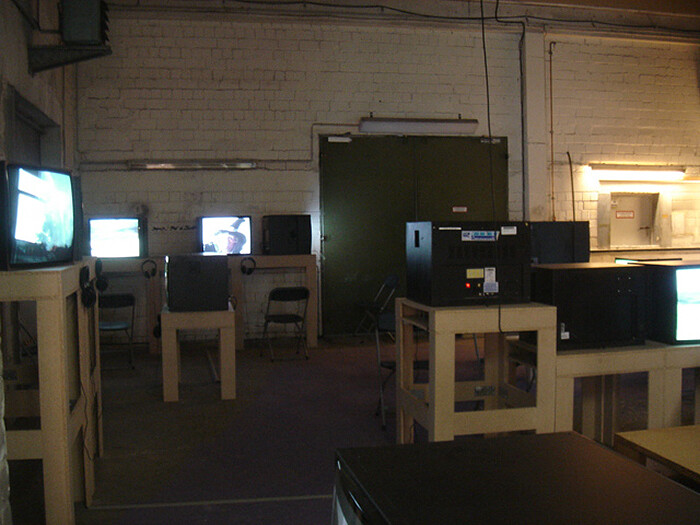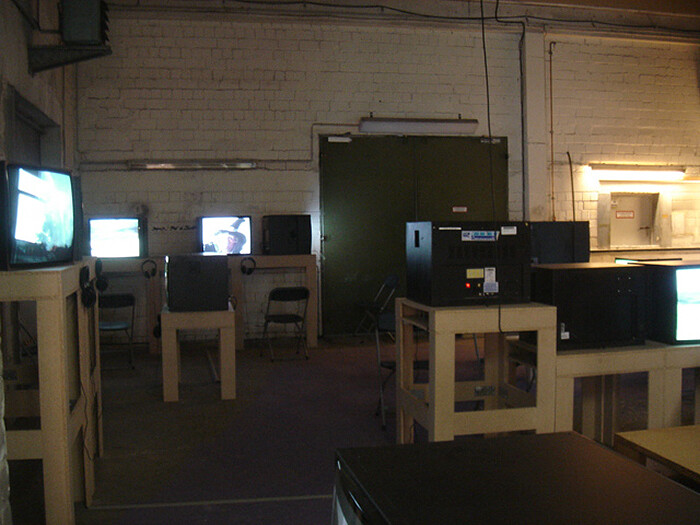Days 2-3: Thursday, June 10th & Friday, June 11th
Day two began at a nondescript warehouse at Mehringdamm 28 to see an installation of George Kuchar films (selected by film curator Marc Siegel) and a brick, (oddly) chapel-like construction housing new sculptural work by Cameron Jamie. Nestled between parking lots and car-repair shops in an industrial patch that has survived the gentrification of the now semi-posh (and ultra-boring) Bergmannkiez section of Kreuzberg, this venue reminded me of summer in Chelsea in the mid-90s, especially given the rapidly rising heat and humidity, which, as the day wore on, made art-viewing increasingly challenging in a city unprepared for such temperatures. There were twenty-three Kuchar films on view—one of the absolute highlights of this biennale—many of them from his “Weather Diary” series (from the 1980s) that combine cleverly edited footage of approaching tornados outside Kuchar’s cheap motel room with his intuitive and funny commentary. A few hundred meters away, the Cameron Jamie installation consisted of two pitch-black rooms lit only by lanterns provided to a restricted number of visitors allowed to enter at any given time. Jamie himself happened to be around and I overheard him warning one of his companions about the spooky content of the piece. Once inside I nervously anticipated “Kranky Klaus”—or, worse yet, a suburban backyard wrestler—to jump out at me from the darkness. Instead there was a series of organic-like ceramic sculptures, along with glazed masks featuring real human hair and teeth. Not as creepy as those homemade props and costumes made by residents of a working-class suburb of Detroit and depicted in his 2003 film Spook House, but the piece works nevertheless.
After a thirty-minute struggle to get by bike through the hoards of tourists mulling slowly around central Mitte, I arrived at Kunst-Werke where I was ushered toward a stairwell leading to a dank, dark basement that resembled the Oranienplatz venue. This detour led to a ground-floor space, filled by a massive wooden construction by Petrit Halilaj (The places I’m looking for my dear are utopian places, they are boring and I don’t know how to make them real, [2010]) with hens wandering around on the floor underneath and in the backyard where a henhouse (They are Lucky to be Bourgeois Hens, [2010]) has been constructed, much to the dismay, I would imagine, of late-risers in neighboring buildings. Enjoying more space than any other artist in the exhibition, Halilaj’s work continued onto the next floor with more messy (some quite lovely) installations utilizing cheap and found materials, prompting one friend to grumble about the Biennale’s revival of arte povera. The floor above was left empty and painted bright white, a welcome relief that provided some pause from the department store vertigo that sets in after consuming too much art too quickly. I particularly liked this “piece” until I learned that it wasn’t a piece at all but a “curatorial decision,” an anonymous, yet authoritative, gesture emblematic of the curatorial heavy-handedness that has become increasingly acceptable as the profession has grown in prestige.
On day three, I began with the two remaining Kreuzberg venues including a former shop just behind the Kottbusser U-Bahn station, an area notorious in Berlin for its reputed drug activity but rather tame to those of us used to the kind of grittier urban environments you encounter outside of Western Europe. At Dresdener Str. 19, a former (and extremely smelly) cafe, I viewed John Smith’s The Girl Chewing Gum (1970): a black-and-white film that shows a street scene in East London where pedestrians and even pigeons follow the stage commands yelled out by the artist in what is, of course, an amusing voice-over. Next stop was Kohlfurter Str. 1, an apartment block filled with the kind of small, low-ceiling apartments that are quite common in eastern Kreuzberg (and that save it from imminent gentrification). I followed the line of visitors, not so easily confused with local residents—a strong visual marker of class and the still elitist nature of contemporary art—up the stairs and into the apartment of Danh Vo. Inside, the artist had carefully arranged a subtle juxtaposition of everyday objects and art pieces. The experience had the potential to be “too relational,” as another friend pointed out, within a potentially contrived ambiguity between art and life. But personally I appreciated the intrusion into another person’s personal space with the resulting discomfort preventing the work from degenerating into feel-good art.
The tour ended at the Alte Nationalgalerie with an Adolph Menzel exhibition curated by Michael Fried. Walking through exhibition rooms that contained Menzel’s meticulously rendered and conceptually larger-than-life paintings and drawings, I remembered how, once upon a time, I’d been captivated by painting, before I was weaned from the medium like most other art professionals who came of age in those decades that witnessed its multiple deaths and revivals. Painting is a slow and self-conscious process and, at its best, it draws attention to the necessity for mediation —a requirement of every medium. After seeing many videos and photographs at the Biennale that documented or manipulated slices of “reality” in an uninspired and bland manner, I recalled Fried’s statement from that first day about how art must represent “what it is like to be in the world, not what the world looks like.” There is no better illustration of this than Phil Collins’s deconstructive and contemplative use of the documentary genre in his film marxism today (prologue) (2010), which operated in stark opposition to the uneffective aggressivity of the adjacent Les Manifs (Protest Marches) (2009) by Bernard Bazile. Titled “was draußen wartet” or “what is waiting out there,” the 6th Berlin Biennale failed to recognize that in an image-saturated society—with its daily spectacle of war, poverty, genocide, environmental devastation, etc.—the critical function of art is not about just showing what’s out there but having something interesting to say about it too.







